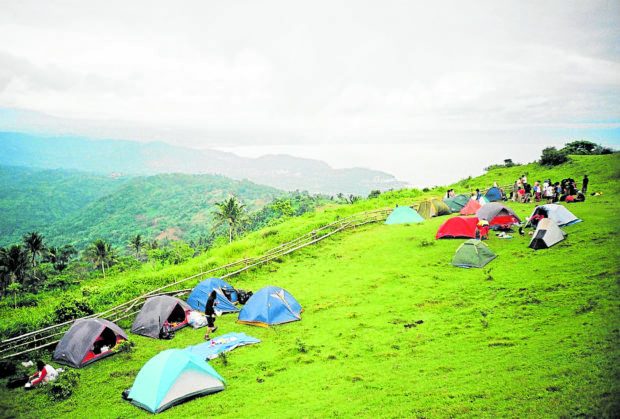
Before the New Year, I found myself walking across a web of rope suspended high above sea level. Underneath me pointed the jagged peaks of a limestone rock. There was no handrail to hold on to, so I took my first steps cautiously and not without some trepidation, even though I have crossed this path before and knew that hundreds more thereafter have crossed this very same rope bridge in complete safety.
I knew I would get to my destination—the center of the spider web with a spectacular view of the forests of Masungi Georeserve—but I still entered slowly, trying not to bounce around an already precarious situation.
This is how I feel as we usher in 2021, a year that everyone hoped and prayed would be better than the unprecedented catastrophe that was 2020. In many ways, it already is.
Domestic travel has restarted in several destinations that the Department of Tourism (DOT) has helped reopen in concurrence with the local governments and in compliance with health and safety protocols. Over the holidays, Boracay welcomed a fair number of visitors, who were thrilled to have pristine swathes of beach to themselves.
This sustainable vision of the island is what landed Boracay on the No. 2 spot of Condé Nast Traveler’s “25 Best Island Beaches in the World” as voted by readers (El Nido came in at No. 9). We can bank on the goodwill and love that foreigners have for our islands to last until international travel resumes once more.
More experience, more science
On the other hand, we are also staring at the imminent appearance of a new variant of the coronavirus. The government’s swift decision to ban travelers or impose strict 14-day quarantines for arriving passengers from the affected countries will contribute to containing the new variant’s transmission. We are in effect experiencing version 2.0 of 2020, but now armed with more experience, more science and the promise of vaccines.
Developing and promoting domestic tourism will continue to be the main strategy we pursue this year. In light of the new COVID variant, entry protocols, quarantine regulations and contact tracing procedures need to be strengthened. The DOT will prioritize the issuance of health and safety guidelines for the operations of other tourism enterprises and activities to ensure the well-being of visitors and workers as well as help improve the readiness of destinations to reopen for business.
We have also begun product diversification and enhancement activities, working with various local government units (LGUs) to recalibrate existing products or develop new offerings.
For instance, the hiking trails of Mt. Gulugud Baboy in Mabini, Batangas, can be expanded on to create more nondiving attractions in Anilao for families, nondivers and divers seeking alternative activities. In Zambales, we are looking to develop and market the area of Botolan, which has been identified as a site rich in potential for water sports, wellness, nature and adventure tourism.
Sohoton Caves and Natural Bridge in Basey, Samar, have undergone preparations, being the first show cave in the country. Villaconzoilo Farm in Jaro, Leyte, also offers new, hands-on farm activities that will delight and impart knowledge to its visitors. We are also enhancing Bukidnon’s mountain and farming activities, such as in Tagoloan River Valley, Lawis Ridge and Taglucop Strawberry Hills, and will position the province as a nature corridor linking the western and eastern parts of Mindanao.
Standardized protocols
Most destinations require the submission of a negative reverse transcription-polymerase chain reaction (RT-PCR) test result within 48-72 hours of travel; to encourage more people to travel, we partnered with the University of the Philippines-Philippine General Hospital (UP-PGH) and Philippine Children’s Medical Center (PCMC) to subsidize 50 percent of RT-PCR costs for tourists. Local travelers can avail of the discounted RT-PCR tests at UP-PGH for P900 and at PCMC for only P750.
In addition to lowering testing costs, we will also see to it that the protocols surrounding domestic travel are streamlined. The widely differing entry requirements from the LGUs, the multiple contact tracing apps that need to be downloaded and the limited travel options available to tourists have been overwhelming. This year, expect guidelines to be more unified and protocols to be standardized as destinations and their LGUs and private stakeholders identify best practices and learn from those that have already reopened.
The concept of tourism has fundamentally changed over the last year, and the DOT has shifted its goals accordingly.
The pandemic has truly unearthed the human side of the tourism industry, and its losses were felt widely and deeply. Our measure of success shouldn’t be based solely on revenue and visitor arrivals, but should also reflect how many jobs have been created, how many sustainable tourism products were developed, and how, through tourism, we are preserving and celebrating Filipino values and culture. As we focus on the task of recovery, we must grow back better for the people and the planet.
In a global campaign with CNN to #RestartTourism, the United Nations World Trade Organization declared that “Movement defines us. Standing still is not an option.” Humans have an inexorable drive to keep going forward, to explore and to conquer. But I will add that there is also a time to stand still. The world stood still for many months in 2020, rendered immobile by the need to stay home and stay safe, sometimes paralyzed by fear. We took a long pause, reassessing the world we have built and reckoning with the consequences.
Now, it is time to release the brakes. —CONTRIBUTED INQ
The author is the Secretary of Tourism.